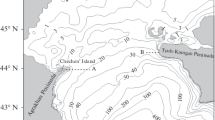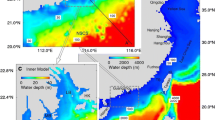Abstract
Seasonal variations in the circulation in the Japan Sea are investigated numerically by using a model basin of uniform depth with three openings, one inflow opening corresponding to the Tsushima Straits and two outflow openings corresponding to the Tsugaru- and Sôya Straits.
From winter to spring, warm water supplied through the inflow opening flows northward along the Korean coast as a western boundary current corresponding to the East Korean Warm Current. From summer to autumn, the warm water splits into two branches; one flows northward along the Korean coast as from winter to spring and the other flows along the Japanese coast as a density-driven boundary current due to the large density difference between the inflowing warm and low salinity water and the interior water which was cooled during winter.
The lack of a boundary current along the Japanese coast from winter to spring results in a large discrepancy between calculated and observed salinity field distributions. Therefore, the nearshore branch of the Tsushima Current can not be explained only as a density-driven boundary current.
The seasonal variation of atmospheric conditions plays an important role in the formation of the Proper Water and the Polar Front in the Japan Sea.
Similar content being viewed by others
References
Bryan, K. (1969): A numerical method for the study of the circulation of the world ocean. J. Comp. Phys.,4, 347–376.
Budyko, M. L. (1974): Climate and Life. Academic Press, New York, 508 pp.
Deacon, E. L. andE. K. Webb (1962): Interchange of properties between sea and air. The Sea: Vol. 1, ed. byH. U. Sverdrup, M.W. Johnson andR. H. Fleming, Wiley Interscience, New York, pp. 49–87.
Friedrich, H. andS. Levitus (1972): An approximate equation of state for sea water, suitable for numerical ocean models. J. Phys. Oceanogr.,2, 514–517.
Fukuoka, J. andA. Misumi (1977): Sinking in the Japan Sea. Bull. Fac. Fish., Hokkaido Univ.,28, 143–153.
Haney, R. L. (1971): Surface thermal boundary condition for ocean circulation model. J. Phys. Oceanogr.,1, 241–248.
Japan Meteorological Agency (1971): Climate Atlas of Japan. Vol. 1. Chijin-shokan, Tokyo, 59 pls.
Japan Oceanographic Data Center (1975): Marine Environmental Atlas: northwestern Pacific Ocean [I] (all months). Japan Hydrogr. Association, Tokyo, 157 plates.
Japan Oceanographic Data Center (1978): Marine Environmental Atlas: northwestern Pacific Ocean [I] (seasonal and monthly). Japan Hydrogr. Association, Tokyo, 164 plates.
Maizuru Marine Observatory (1972): Marine meteorological study of the Japan Sea. Tech. Rep. Japan Meteorol. Agency, (80), 1–116.
Miita, T. (1976): Current characteristics measured with current meters at fixed stations. Bull. Japan Soc. Fish. Oceanogr.,28, 33–58.
Miyazaki, M. (1952): The heat budget in the Japan Sea. Rep. Hokkaido Reg. Fisher. Res. Lab., 4, 1–45. (in Japanese).
Munk, W. H. (1950): On the wind-driven ocean circulation. J. Meteor.,7, 79–93.
Nan'niti, T. andA. Fujiki (1967): Secular variations of hydrographic conditions in the East Tsushima Strait. J. Oceanogr. Soc. Japan,23, 201–212. (in Japanese).
Sheppard, D. A. (1958): Transfer across the earth's surface and through the air above. Q.J.R. Met. Soc.,84, 205–224.
Yi, S. U. (1966): Seasonal and secular variations of the water volume transport across the Korea Strait. J. Oceanogr. Soc. Korea,1, 7–13.
Yoon, J. H. (1982): Numerical experiment on the circulation the Japan Sea. Part I: Formation of the East Korean Warm Current. J. Oceanogr. Soc. Japan,38, 43–51.
Yoon, J. H. (MS): Numerical experiment on the circulation in the Japan Sea. Part III: Formation of the nearshore branch of the Tsushima Current. J. Oceanogr. Soc. Japan, 38(3) (in press).
Yoon, J. H. andN. Suginohara (1977): Behavior of warm water flowing in to a cold ocean. J. Oceanogr. Soc. Japan,33, 272–282.
Author information
Authors and Affiliations
Rights and permissions
About this article
Cite this article
Yoon, JH. Numerical experiment on the circulation in the Japan Sea. Journal of the Oceanographical Society of Japan 38, 81–94 (1982). https://doi.org/10.1007/BF02110294
Received:
Revised:
Accepted:
Issue Date:
DOI: https://doi.org/10.1007/BF02110294




